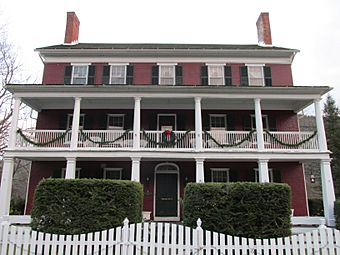Merrell Tavern facts for kids
|
Merrell Tavern
|
|
|
U.S. Historic district
Contributing property |
|

Merrell Inn
|
|
| Location | 1565 Pleasant St., South Lee, Massachusetts |
|---|---|
| Area | 1 acre (0.40 ha) |
| Built | 1794 |
| Architectural style | Greek Revival, Federal |
| Part of | South Lee Historic District (ID99000237) |
| NRHP reference No. | 72000136 |
Quick facts for kids Significant dates |
|
| Added to NRHP | February 23, 1972 |
| Designated CP | February 18, 1999 |
The Merrell Tavern, also known as the Merrell Inn, is a very old and special building in South Lee, Massachusetts. It was built way back in 1794. For almost 200 years, it has been a place where travelers could stay and rest. Today, it still welcomes guests as a bed and breakfast! It's famous for keeping its original look from the early 1800s. The Merrell Tavern was added to the National Register of Historic Places in 1972 because of its important history.
Discovering the Merrell Inn
The Merrell Inn is a large, three-and-a-half-story building. It is made of wood, but it has brick walls on the sides. The front of the building has a two-story porch. This porch stretches all the way across the front. The first floor of the porch has square columns. The second floor has round columns, which are a style called Doric.
A Look at the Inn's History
The Merrell Tavern was first built in 1794. It was a home for Joseph Whiton, who was a local leader in the community. It was one of the first brick houses built in this area during the Federal period. This was a time when a certain style of architecture was popular in the United States. Some of its design ideas came from drawings by a famous architect named Asher Benjamin.
In 1815, the Merrell family bought the building. They turned it into a tavern, which is like an inn or a hotel. The Merrell family ran the tavern for over 100 years! They made the building bigger in 1838. They added a third story, which included a large room for dancing called a ballroom. They also added the two-story porch you see today.
One of the most amazing parts of the inn is its old taproom. A taproom is where drinks were served. This room still looks almost exactly as it did long ago. It even has its original painted wood, which was made to look like oak wood grain.
Later, in the 1900s, a group called the Historic New England (HNE) bought the inn. This group works to save old buildings. For a while, they ran the Merrell Inn as a museum. Now, the inn is owned by a private family again. However, HNE still helps make sure the building's history is protected.



